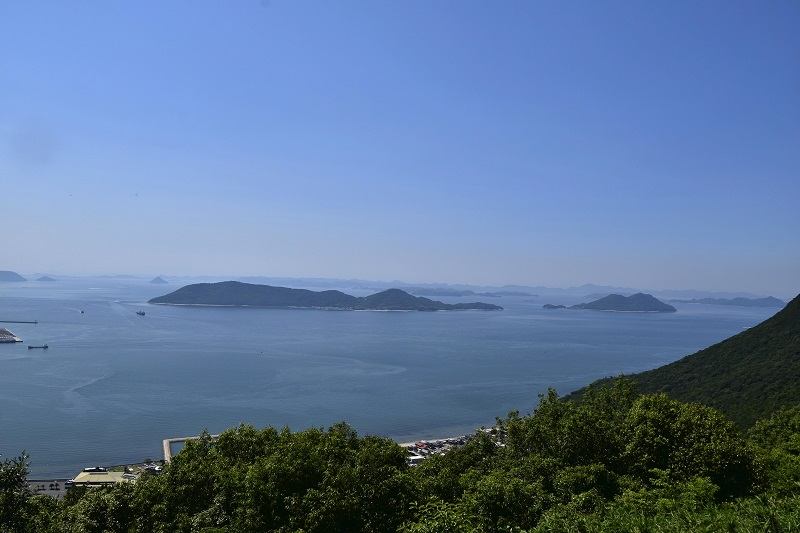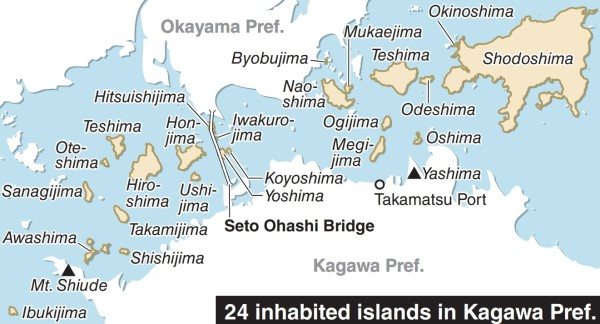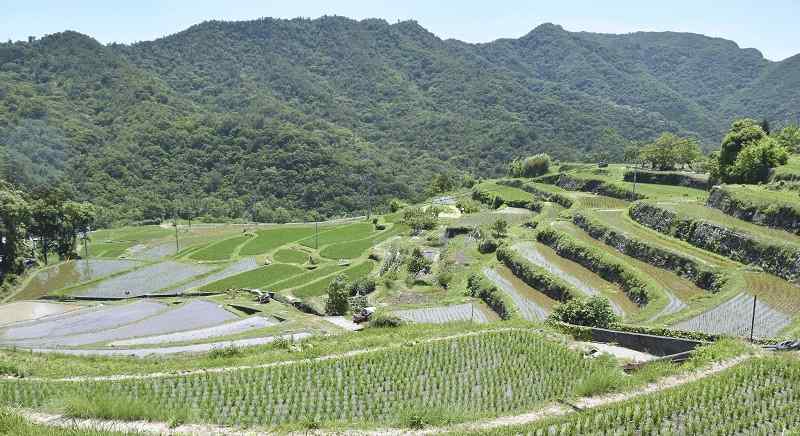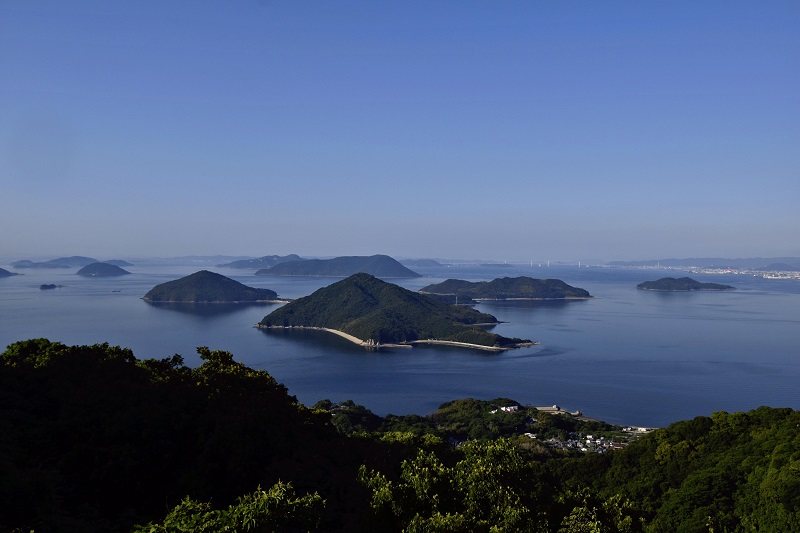
Island views from Yashima
16:13 JST, August 8, 2021

A map of the 24 inhabited islands in Kagawa Pref.
TAKAMATSU — Thanks to the popularity of the Setouchi Triennale, an art festival held once every three years since 2010, more and more people are becoming drawn to the islands in the Seto Inland Sea.
Among them, there are 24 inhabited islands that belong to Kagawa Prefecture. Each of them has its own draw, such as nature, unique history, culture and traditions.
Multi-island beauty
In the mountains of Shodoshima island, the largest of the 24 isles, you can see terraced rice paddies known as Nakayama Senmaida. About 800 paddies are spread out at an altitude of 150 to 250 meters above sea level, creating the landscape of a primitive Japanese farming village.
Islands of the Seto Inland Sea, including Shodoshima island, were formed via crustal movement and erosion after volcanic activity about 14 million years ago. The inland sea is called the “Aegean Sea of the East” and the “Jewel of the World” because of the beauty of its scenery.
“You will find something different at whichever island you explore,” said Shuichi Hasegawa, a specially appointed professor at Kagawa University. “That is the beauty of the Seto Inland Sea.”
The Shodoshima and Teshima islands are relatively flat while Ozuchijima and Kozuchijima, both uninhabited islands, have steep terrain. The lack of uniformity in terrain comes from the difference in the strata deposited on each island, caused by non-uniform volcanic eruptions that formed each island.
“The islands are not at all alike, making the beautiful scenery all the more valuable,” he said.

The Nakayama Senmaida terraced rice paddies are seen in Shodoshima island.
Preserving terraced paddies
Shodoshima, in particular, is characterized by its clay soil, which has excellent water retention. Such soil, along with high-quality spring water, has long helped Shodoshima farmers produce high-quality rice.
However, as there is a shortage of rice farmers on the island, abandoned paddies are becoming more noticeable.
In April, the local Shodoshima town government hired Hironori Ogiso from Yokohama to work on preserving the terraced rice paddies. He was also given the tasks of discovering any challenges in farming and creating new attractions.
Ogiso, 37, quit the company he worked at for more than 10 years and moved to the island with his wife and two daughters.
It is said that farming rice in terraced paddies is “twice the work and half the yield.” For example, farmers must plow multiple fields and cannot bring large machinery to the paddies. Still, Ogiso is learning the basics of rice farming on terraced paddies.
“I’d like to make the work even better and develop it further,” he said.
Spectacular spots
Beautiful scenery created by numerous islands can be found in the Seto Inland Sea, and it is beloved among tourists for its photogenic landscape.
It is said that in the mid-19th century, at the end of the Edo period, a geographer who came to Japan praised the islands in the Seto Inland Sea as “the most beautiful in the world.”
You can also witness a spectacular view from Shodoshima.
Many tourists visit the Kankakei gorge for a great view on Shodoshima island. If you take a gondola lift that goes through the gorge, you can enjoy the natural beauty that was formed over the centuries. From the summit above the gorge, you can see other islands and even Shikoku.
You can see fantastic scenery of the islands from Shikoku as well. Yashima in Takamatsu was originally an island, though now it is connected to Shikoku via land reclamation conducted in the early 17th century. From there, you can get excellent night views of the Ogijima and Megijima islands. Mt. Shiude in Mitoyo also offers a beautiful view that includes many islands.

A map of the Shodoshima island
Olive-fed wagyu to the world
Odeshima island, located about 5 kilometers west of Shodoshima, has an area of about 1.1 square kilometers. While the population was only 12 as of June this year, the islanders are raising about 300 cows there to produce a brand of olive-fed wagyu beef.
“The island has nothing to boast of except the beef,” said Koichi Takeuchi, 82, who has been raising livestock on the island for more than 50 years.
Olive-fed wagyu began in earnest in 2010 in Kagawa Prefecture. The beef has gradually gained popularity for its light, refreshing flavor and has been exported overseas since 2012. The 2,580 olive-fed cows were shipped from the prefecture last year. The brand is said to also be popular in Southeast Asian countries and the United States.
“I’m proud that such a small island is delivering something around the world,” said Takeuchi, who keeps nearly 180 cows. He said he is not going to quit the business, although shipping livestock by boat is costly. “I hope to lift up our island as much as possible.”

Island views from Mt. Shiude
Related Tags
"Features" POPULAR ARTICLE
-

Sanrio to Open Museum in Yamanashi Pref. Dedicated to Founder, Exhibits Include Hello Kitty, Other Characters
-

Autumn Foliage Surrounds Visitors to Tokyo’s Showa Kinen Park
-

My Daughter No Longer Speaks to Me, But I Want to See Her and My Grandchild
-

Kumamoto: Public Bath Refurbished as Library Where You Can Chat, Take Photos
-

Frozen Vegetables: Demand Rises for Convenient, Tasty Domestic Produce
JN ACCESS RANKING
-

Tokyo Economic Security Forum to Hold Inaugural Meeting Amid Tense Global Environment
-

Keidanren Chairman Yoshinobu Tsutsui Visits Kashiwazaki-Kariwa Nuclear Power Plant; Inspects New Emergency Safety System
-

Imports of Rare Earths from China Facing Delays, May Be Caused by Deterioration of Japan-China Relations
-

University of Tokyo Professor Discusses Japanese Economic Security in Interview Ahead of Forum
-

Japan Pulls out of Vietnam Nuclear Project, Complicating Hanoi’s Power Plans

























